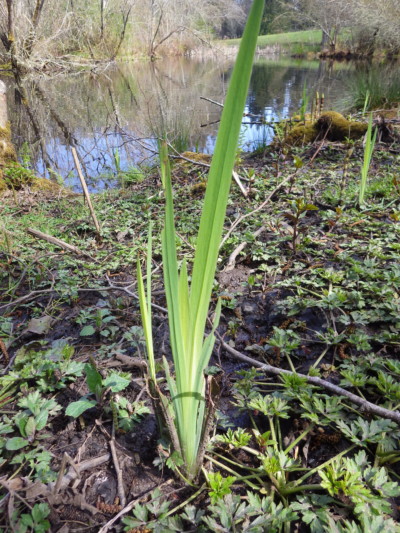Weeds 101: Yellow Flag Iris
A Pretty Imposter
Weeds make their way into everyone’s landscapes and the Bloedel Reserve is no exception. Some weeds can be so troublesome that the state puts them on an official Noxious Weed List. The battle against noxious weeds is an ongoing fight at the Reserve. Fortunately, Bloedel has Tobin Tripp, our staff weed expert (along with his many other skills).
Tobin describes Yellow Flag Iris (Iris pseudacorus) as an aggressive, fast-growing plant that can take over riparian areas, cause ecological damage, and can be toxic if to livestock. Fond of waterlogged soils, it took over sections of the pond edge at the Buxton Bird Marsh many years ago.
Often guests who see it for the first time may not realize it is an invasive weed. It produces a large, yellow, very attractive flower that resembles many garden iris varieties and doesn’t fit most people’s idea of a noxious weed. Native to Europe, North Africa, and the Mediterranean region, Yellow Flag Iris is, in fact, cultivated as an ornamental flower in some parts of the world. It is possible that it was introduced to our area as a garden plant in someone’s private garden that then escaped its backyard.
Easy to Spread, Tough to Remove
With its vigorous seed production, it can quickly crowd out native riparian vegetation that fish and birds use for habitat. The seeds look like small, round “coins” about the same diameter as a pencil or smaller. They spread by floating to a new location at the edge of the water. Without intervention, this weed can completely take over some bodies of water. Yellow Flag Iris most commonly occurs at Bloedel is along the Buxton Bird Marsh pond edge where it can fill in and crowd out other plants.

Once Yellow flag Iris seeds into an area, it can spread further via tough rhizomes (underground horizontal root structures capable of producing additional plants). Unfortunately mechanical ploughing usually just breaks the rhizomes into pieces that continue to grow almost unhindered. Tobin’s best method of control is to pull and dig out the rhizomes by hand, making sure to remove as much of the plant as possible. With help from other staff, Tobin and Bird Marsh manager Dave Jacobs have managed to greatly reduce the impact of Yellow Flag Iris at the Bird Marsh.
Because the plant’s resins can cause some skin irritation, anyone tackling this iris species in their own garden or pond should take care to wear protective gloves and long sleeves when handling the leaves and rhizomes. We strongly discourage composting noxious weeds, particularly their seeds, roots, or rhizomes. Composting is not guaranteed to completely destroy these plants. If they cannot be disposed of some place where they cannot continue to grow, the best action is to bag them and place them into a garbage can.
SIGN UP FOR OUR ENEWSLETTER
Stay up to date on all of the events and activities taking place at Bloedel Reserve.


